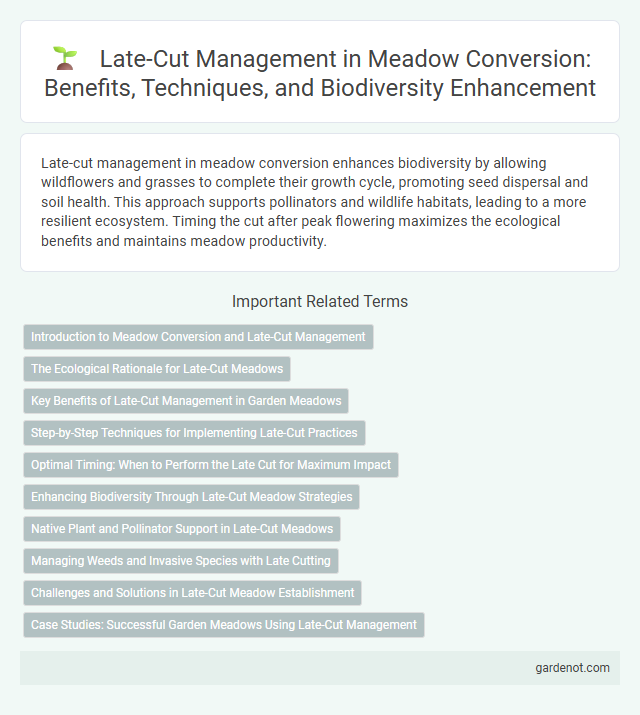Late-cut management in meadow conversion enhances biodiversity by allowing wildflowers and grasses to complete their growth cycle, promoting seed dispersal and soil health. This approach supports pollinators and wildlife habitats, leading to a more resilient ecosystem. Timing the cut after peak flowering maximizes the ecological benefits and maintains meadow productivity.
Introduction to Meadow Conversion and Late-Cut Management
Meadow conversion enhances biodiversity and forage quality by promoting native plant growth through late-cut management. Late-cut management involves delaying the first cut until after key wildflowers have flowered and set seed, supporting pollinators and wildlife habitats. This method improves soil health and increases the resilience of meadows to environmental changes.
The Ecological Rationale for Late-Cut Meadows
Late-cut meadow management promotes biodiversity by allowing wildflowers to complete their reproductive cycles, supporting pollinators like bees and butterflies. Extended growth periods increase habitat complexity for invertebrates and ground-nesting birds, enhancing ecosystem stability. Delayed cutting also improves soil health by maintaining organic matter and fostering nutrient cycling essential for meadow resilience.
Key Benefits of Late-Cut Management in Garden Meadows
Late-cut management in garden meadows enhances biodiversity by allowing wildflowers and grasses to complete their life cycles, promoting seed dispersal and habitat for pollinators. This method optimizes nutrient retention in the soil, improving plant health and reducing the need for artificial fertilizers. By timing cuts later in the season, ecosystems benefit from increased structural diversity and improved ecosystem resilience.
Step-by-Step Techniques for Implementing Late-Cut Practices
Late-cut management in meadow conversion involves a strategic delay in harvesting to enhance biodiversity and improve forage quality. Begin by scheduling the first cut after peak flowering to support pollinator habitats and seed dispersal. Gradually adjust mowing frequency annually, monitoring grass regrowth and soil health to optimize nutrient cycling and maximize meadow sustainability.
Optimal Timing: When to Perform the Late Cut for Maximum Impact
Performing the late cut between late August and early September ensures maximum regrowth and nutrient retention in meadow conversion. This timing allows grasses to store carbohydrates efficiently, supporting robust root systems and improved forage quality. Delaying the cut beyond early September risks decreased biomass and reduced soil fertility due to premature plant dormancy.
Enhancing Biodiversity Through Late-Cut Meadow Strategies
Late-cut meadow management significantly enhances biodiversity by allowing wildflowers and grasses ample time to complete their reproductive cycles, supporting a wider range of pollinators and ground-nesting birds. Delaying the first cut until late summer promotes seed dispersal and increases habitat complexity, essential for invertebrates and small mammals. This strategy aligns with agri-environment schemes aimed at preserving rare plant species and boosting ecosystem resilience.
Native Plant and Pollinator Support in Late-Cut Meadows
Late-cut management in meadows promotes native plant diversity and enhances pollinator habitats by allowing flowering species to complete their reproductive cycles. This practice supports key pollinators such as bees, butterflies, and moths by providing abundant nectar and pollen resources during critical late-season periods. Maintaining late-cut meadows ensures the preservation of native flora and sustains crucial ecological networks for pollinator populations.
Managing Weeds and Invasive Species with Late Cutting
Late-cut management effectively controls weeds and invasive species by allowing desirable plants to set seed before mowing, which suppresses unwanted vegetation over time. This method enhances biodiversity in meadows and reduces reliance on herbicides by targeting invasive species when they are most vulnerable. Consistent late cutting supports native flora dominance and helps maintain a healthy, balanced ecosystem.
Challenges and Solutions in Late-Cut Meadow Establishment
Challenges in late-cut meadow establishment often include reduced seed germination rates and slower vegetation recovery due to shortened growing seasons. Implementing adaptive management techniques, such as selecting fast-maturing native grass species and optimizing cutting schedules, enhances meadow resilience and biodiversity. Utilizing soil amendments and controlled fertilization further supports robust plant growth and successful late-cut meadow conversion.
Case Studies: Successful Garden Meadows Using Late-Cut Management
Late-cut management in garden meadows sustains biodiversity by allowing plants to complete their reproductive cycles, resulting in increased habitat for pollinators and wildlife. Case studies show that meadows cut after mid-July achieve higher species richness and greater floral density compared to early-cut regimes. Successful implementations in Europe and North America demonstrate improved soil health and aesthetic appeal, promoting long-term ecological balance.
Late-cut management Infographic

 gardenot.com
gardenot.com